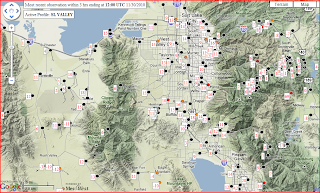
The 12 UTC sounding shows both the existence of the surface based inversion and indicates that the strong subsidence layer has descended to crest level as expected. The elevated subsidence inversion was also evident in mountain top observations where warming and drying were observed. Between these two layers a region of much weaker static stability is found.

While it is tempting to assume that the whole valley is represented by this sounding, significant variations in temperature and cold pool structure are suggested by some of the observations in the south end of the valley near the Jordan Narrows and the Traverse Ridge.

Examining the temperature time series at 4 stations (Point of the Mountain, Flight Park, Bluffdale, and a site near Bangeter Highway) drastic differences in the temperature evolution are apparent.
 The flight park and I-15 Point of the Mountain both show nearly steady cooling through the night. The 'Murray' site shows rapid cooling with a potent cold pool forming and temperatures near 0 F, then a rapid temperature increase. The Bluffdale site has more modest cooling, interrupted towards morning by successive temperature jumps and drops.
The flight park and I-15 Point of the Mountain both show nearly steady cooling through the night. The 'Murray' site shows rapid cooling with a potent cold pool forming and temperatures near 0 F, then a rapid temperature increase. The Bluffdale site has more modest cooling, interrupted towards morning by successive temperature jumps and drops.Taking a cursory look at the data from the ISFS sites around the valley we can see that this temperature jump behavior is unique to this portion of the valley. The Riverton site behaves similarly to the 'Murray' site, with a rapid warm up before 12 UTC. The other sites show a more consistent behavior and can roughly be subdivided into two groups (indicated by the departures from the group mean plot below), those that develop robust cold pools (the cold group) and those that experience less cooling.


What drives these variations? It is difficult to say.... internal turbulence and strong associated heat flux? Hydraulic jumps in the stable flow near terrain? Sloshing of the cold pool? These are all questions that we hope to be able to further explore during PCAPS.
Further complexities within the cold pool developed during the day as some locations where able to mix out the nocturnal surface based cold pool, a substantial accomplishment in light of the snow pack on the ground. Nonetheless the strong subsidence inversion descended further below crest level, keeping the valley air trapped in place. Above this inversion, thick altostratus moved in during the afternoon and some very weak radar returns are now apparent. Just what changes are in store for the cold pool structure overnight?
Here is the starting point this evening... what will we see in the morning?

OPERATIONS NOTE: ISS soundings at 18 UTC and 06 UTC will commence tomorrow (Dec 1st) and continue until the demise of the current cold pool which is currently anticipated to occur on Dec 3rd.
No comments:
Post a Comment